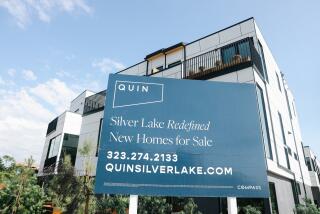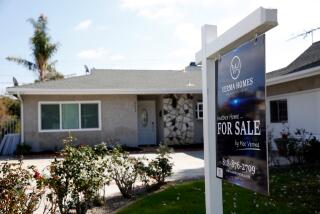Southern California housing market slows after torrid rebound
Southern California home buyers have apparently had their fill of bidding wars, home shortages and double-digit price hikes.
For the third straight month, the median home price across the Southland stayed essentially flat, at $382,000. The September data confirmed expert predictions that waning demand would throw a wet blanket over the white-hot market. The stall is owed to multiple factors: buyer fatigue over skyrocketing prices, higher mortgage rates, an expanding supply of homes and a pullback by investors who had swarmed the market.
The cooling has quelled fears of another housing bubble and signals a welcome return to normality, experts say. The California Assn. of Realtors predicts that year-over-year price increases will return to 6% next year, more in line with historical norms.
“The market was starting to get too hot for a lot of people to touch,” said Stuart Gabriel, director of UCLA’s Ziman Center for Real Estate. “Now we are moving toward a more sustainable growth path.”
The rapid run-up in prices peaked in June — with a whopping 28% year-over-year increase in the median price. Sellers dominated the market, often getting multiple bids for more than the asking price amid heavy demand and scarce supply. But sellers listing their homes now are finding a different, more empowered, class of buyers.
“They don’t feel the need to pull the trigger if it’s not a perfect house,” said Broker Derek Oie, owner of Century 21 the Oie Group in the Inland Empire.
Nancy Taylor and her ex-husband placed their Chino Hills house on the market in August. They put in roughly $20,000 to spruce up the five-bedroom home, getting it ready for what they expected to be a mad rush, filled with “tons of people knocking on our door.”
Not so much. To sell the home, they had to cut their asking price and purchase a new stove top, dishwasher, microwave and oven for the eventual buyers, who closed this month — at a $20,000 discount off the asking price.
“It’s sticker shock,” said John Burns, a housing industry consultant in Irvine. “The market is stepping back and pausing for a moment and absorbing the new price increases and higher interest rates.”
Part of the slowdown is seasonal. Buyer demand tends to slow in the fall as some families are hesitant to move with children back in school and the holidays approaching. But experts believe that larger market forces account for much of the decline in demand.
If the current rebound is similar to previous Southern California housing booms, prices will rise substantially during next year’s spring buying season, said Lee Ziff, an agent who covers L.A.’s Westside. “Next year will be even bigger,” he said.
For now, the pullback has made life easier for buyers.
In June, Steve Libuser and his wife toured a three-bedroom house in Camarillo. Libuser said his wife fell in love with the house and placed an offer that day. Only one other offer came in. The couple closed Wednesday, buying the house for slightly less than the $879,000 asking price.
“It was a very easy experience,” said Libuser, a 62-year-old insurance agent.
The housing recovery started last year and kicked into overdrive this year as traditional home buyers and investors — including well-heeled Wall Street firms — rushed into the market, eyeing rock-bottom interest rates and beaten-down home prices. Convinced that the housing crash had finally bottomed out, buyers rushed in. Some even placed bids on houses without touring the homes, agents say — an act of desperation as families battled with all-cash investors amid a historic shortage of homes.
Now prices and mortgage rates have climbed to the point where many buyers have checked out.
Sellers tempted by this year’s price appreciation are increasingly testing the market at the same time that demand is waning. That has caused some sellers to reduce their asking prices — a dose of reality, agents say.
Buyers are also demanding more repairs from sellers — and getting them.
“In April and in March, buyers pretty much took it as is,” said Carole Vicens, an agent who works in the Conejo Valley.
The number of listings rose in September from a month earlier in the Inland Empire, as well as Los Angeles, San Diego, Orange and Ventura counties, according to Realtor.com.
Even as listings rose, sales tumbled. A total of 19,112 houses and condos sold in September throughout the six-county region, a 17.1% drop from August, real estate firm DataQuick reported Wednesday, along with the median price figures.
That’s a far sharper decline than the typical seasonal slowing, an indication that buyers have become priced out or frustrated enough to walk away. Since 1988, when DataQuick starting tracking the market, sales have fallen an average of 9.3% from August to September.
Sellers have gotten a “wake-up call,” said Steven Thomas of ReportsOnHousing.com. Asking prices have been trimmed, traffic at open houses has slowed and multiple offers are harder to attract.
“It’s like everyone dialed it down,” he said.
The slowing is not just local but national. The pace of monthly price increases slowed in most of the 20 large metros tracked by July’s Standard & Poor’s/Case-Shiller index, the latest data available. July and August were also the worst months this year for sales of new homes nationally, a more timely indicator based on signed contracts.
Even homes in good locations and priced right are sometimes languishing on the market longer, South Bay real estate agent David Keller said. “It should go pretty quick, and then it doesn’t,” he said.
Higher prices mean that sellers no longer have all-cash investors flooding them with offers. Absentee buyers — mostly investors — purchased 26.3% of Southland homes sold last month, the lowest level since November 2011.
But inventory remains tight, and experts say the housing recovery continues to move forward. September sales were up 7% from a year before. The median sales price was 21.3% higher, although year-over-year gains are easing as well.
“It’s still a seller’s market, it’s just not this crazy seller’s market,” Thomas said.
Home prices will rise slowly over the next year, said Richard Green, director of USC’s Lusk Center for Real Estate. That’s appropriate, given the relatively slow growth in personal income, he said.
“We are now probably in the most normal housing market we have been in for 12, 13 years,” he said.






